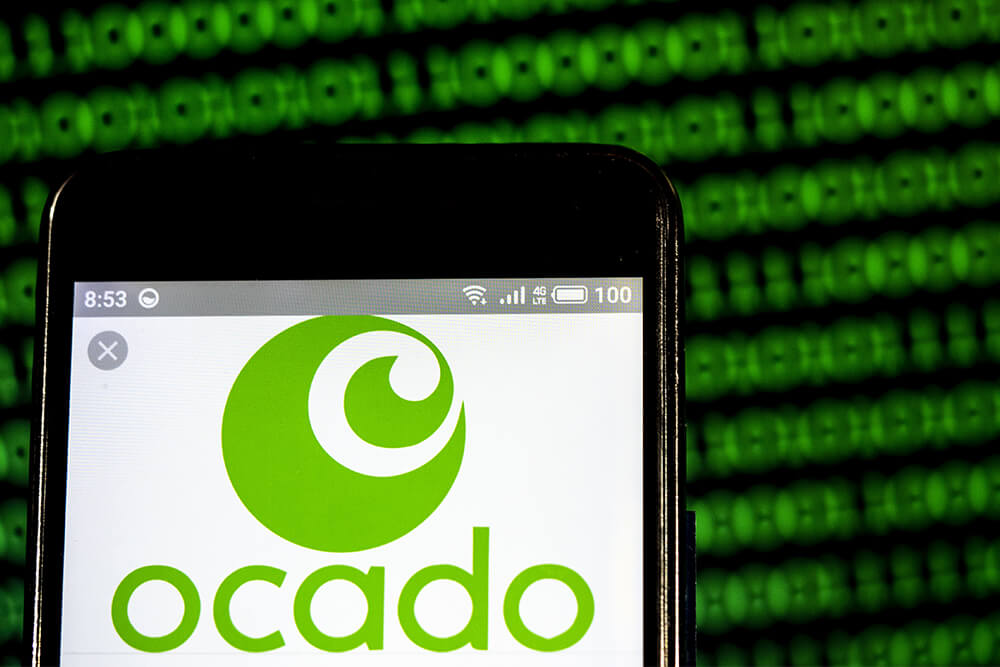The Amazing Ways Ocado Uses Artificial Intelligence And Tech To Transform The Grocery Industry
2 July 2021
While many know UK company Ocado as an online grocery retailer, it’s really one of the most innovative tech companies in the world. Ocado was founded in 2000 as an entirely online experience and therefore never had a brick-and-mortar store to serve its customers, who number 580,000 each day. Its technology expertise came about out of necessity as it began to build the software and hardware it needed to be efficient, productive, and competitive. Today, Ocado uses artificial intelligence (AI) and machine learning in many ways throughout its business.

From Online Retailer to Ocado Technology
Since 2000, Ocado tried to piece together the technology they needed to succeed by purchasing products off the shelf. They quickly realized these off-the-shelf solutions weren’t suitable for the unique demands of an online grocery, so they set out to build the hardware and software they needed. Today, the Ocado Smart Platform runs end-to-end e-commerce and is being sold to other brick-and-mortar grocery retailers such as Canadian grocer Sobey’s, French retailer Groupe Casino, Aeon in Japan, Kroger in the United States, ICA in Sweden, and others around the world. Ocado Technology is helping to provide software as a service and hardware to help other grocers operate profitably and sustainably online. Ocado Technology has led the industry in innovation for years, from launching the first grocery app in 2009 to being the first UK supermarket to have an Alexa app.
Automated warehouses
Ocado’s warehouses are fully automated. The company’s warehouses illustrate the power of Industry 4.0, where technology trends such as the Internet of Things, robotics, big data, machine learning, and artificial intelligence are at work every day, making Ocado’s operations streamlined and efficient—in just 5 minutes robotics can complete 50,000 orders. The choreography of the robots—a swarm—is something to behold as they navigate around warehouses the size of several football fields, pick up bins and deliver them to pick stations to complete customer orders. Ocado made this system completely scalable to accommodate the evolving needs of online grocers during changing seasons, promotions, and events such as a global pandemic. This robotic workforce is powered by big data and artificial intelligence and becomes better through machine learning. Machine learning determines the traffic flow of the robots through the warehouse to prevent collisions and to optimize efforts, calculates the precise placement of bins for maximum efficiency, and also monitors the health and maintenance needs of the robots to reduce any downtime. Artificial intelligence also helps the system understand what products are in stock through real-time availability, so they are able to give customers what they expect to receive.
Reduce food waste
It is estimated by the Food and Agriculture Organization of the United Nations that we waste around 1.3 billion tons of food each year on earth. If we could stop the waste, there would be enough food to feed all the world’s hungry and even have food leftover. Technology could help us solve the world hunger problem, and Ocado might just be leading the way to a solution. Ocado uses machine learning, artificial intelligence, and data analytics to slash its food waste to just losing 1 in 6,000 produce items. The Ocado Smart Platform determines the food customers want and need and adjusts orders from suppliers accordingly. The company’s platform assesses 20 million forecasts each day to maximize freshness and availability while reducing overstock and waste. Additionally, the machines help determine the optimal time for discounts to push out all inventory.
Artificial intelligence and machine learning also help reduce food waste by ensuring that products are stored or delivered in a way and at temperatures that reduce the likelihood of spoilage. It donates produce to those in need that are only a few days away from expiring. Machine learning algorithms help the company effectively monitor and manage this donation effort.
Better customer service
As you might be able to ascertain, customer service is a priority for Ocado, and having the products customers want available and fresh, greater personalization, and smarter product recommendations are certainly ways to create a stellar customer experience. While customer interaction isn’t the same as it would be in a brick-and-mortar store, customers do interact with Ocado delivery drivers whose delivery routes are constantly evolving as AI determines how to circumnavigate the city to avoid traffic and other delays or when they interact with Ocado’s contact centers via a phone call or email. These are also areas where Ocado puts technology to work.
At Ocado’s contact centers, they allow customers to contact the company in a variety of ways (email, social media, phone call). But, this isn’t what sets its customer service apart because most companies who prioritize the customer experience do the same. Ocado differentiates its customer service experience by applying machine learning and natural language processing algorithms to quickly categorize customer communications to prioritize the message and get it to the right team to solve the issue as quickly as possible.
Combat fraud
Another development out of Ocado Technology is what it claims to be the world’s first AI-based fraud detection system for online grocery purchases. The advanced machine learning algorithm has already improved fraud detection by a factor of 15.
Ocado continues to innovate to use technology, including artificial intelligence and machine learning, to optimize warehouses, reduce food waste, improve customer experience, and combat fraud. If it’s not already there, expect the Ocado Smart Platform to help support the online operations of a grocer near you very soon.
AI is reshaping businesses of all shapes and sizes across all industries. Discover how to prepare your organization for an AI-driven world in my new book, The Intelligence Revolution: Transforming Your Business With AI.
Related Articles
Sex And Intimacy In The Generative AI Era
Sex and technology have long been intertwined – millions of us use dating apps to find partners, and some of the earliest commercial online activity revolved around pornography.[...]
Generative AI Sucks: Meta’s Chief AI Scientist Calls For A Shift To Objective-Driven AI
In a landscape where generative AI is hailed as the frontier of technological innovation, Yann LeCun, Chief AI Scientist at Meta, presents a contrarian viewpoint that challenges the status quo.[...]
Instacart Harnesses Generative AI To Revolutionize Grocery Delivery Experience
Grocery delivery and pickup service Instacart is not shy about adopting new technologies. So, it makes sense that the company has embraced generative AI across the business.[...]
Responsible AI: Why Privacy Is An Essential Element
Today, people often talk about “responsible” AI use, but what do they really mean?[...]
The Amazing Ways IKEA Is Using Generative AI
Global furniture retailer IKEA has long been at the forefront of tech-driven retail innovation.[...]
Generative AI Is Coming To Your Home Appliances
Across all industries, organizations are rapidly embracing generative AI. Among them, makers of home appliances like fridges and ovens.[...]
Sign up to Stay in Touch!
Bernard Marr is a world-renowned futurist, influencer and thought leader in the fields of business and technology, with a passion for using technology for the good of humanity.
He is a best-selling author of over 20 books, writes a regular column for Forbes and advises and coaches many of the world’s best-known organisations.
He has a combined following of 4 million people across his social media channels and newsletters and was ranked by LinkedIn as one of the top 5 business influencers in the world.
Bernard’s latest book is ‘Generative AI in Practice’.










Social Media